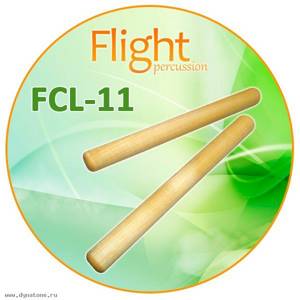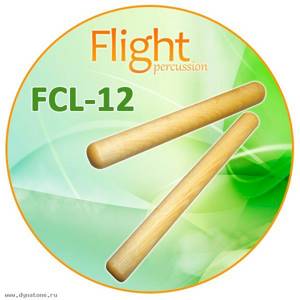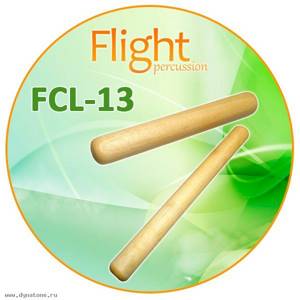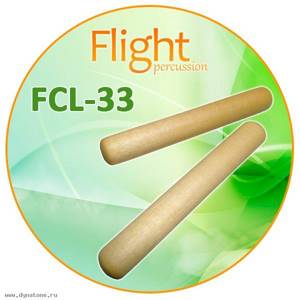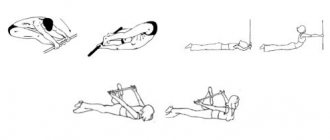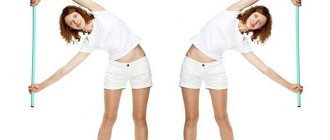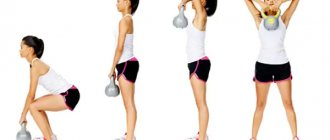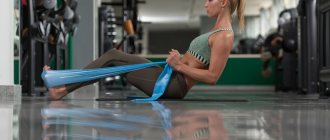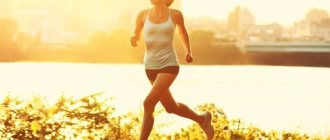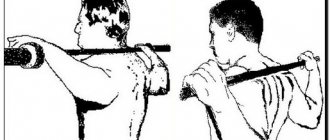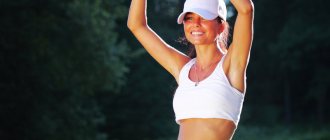A gymnastic stick helps stabilize the load on the body and distribute weight, but at the same time it makes it possible to perform more effective and varied training. If you consider yourself to be one of the people who cannot stand routine and monotony, then this is just for you.
Among all the items for training, a gymnastic stick is the most affordable and versatile equipment. In addition, to do an exercise with a stick, you don’t have to buy one. We have more than enough of these weapons. You simply clean your stick of everything unnecessary and use it, rejoicing that you didn’t spend a single ruble on your training.
Benefit
A set of exercises with a stick can be called, with a clear conscience, general developmental. It makes it possible to pump up your buttocks, thighs, arms, abs, chest, calves, whatever! In addition, it is used in various types of martial arts as a weapon.
And the second convincing fact in order to dispel all doubts and stimulate interest in such exercises: the famous Gwyneth Paltrow works out with a gymnastic stick! This method of losing weight was “prescribed” to her by Tracy Anderson, one of the best trainers in Hollywood. So let’s take her as an example and get started!
Standing position
To do this exercise with a stick, stand with your feet shoulder-width apart and place the stick on your shoulders. We turn the body to the left, the legs and pelvis remain in place. We return to the starting position. We turn the body to the left. Let's go back.
Next exercise. Stand up, stick up. Tilt your body to the right, return to the starting position. Lean to the left, come back. The stick moves in a vertical plane.
In the same position, bend forward, while bending your back as much as possible (in the thoracic region and lower back), the back of your head and back are in one line, your legs are straight. Raise your arms up and forward, moving the stick back as far as possible. Return to starting position.
In order to do the following general developmental exercises with a stick, you need to stand in the same position. Only the equipment should be directly in front of the chest. Bend towards your right leg, preferably placing a stick on the floor in front of it. Return. Do the same with the left leg.
Keep the stick down in the same position. Lean forward with her, straight back, look strictly in front of you. Pull the stick to your chest, bending your arms, bringing your shoulder blades together, with your elbows pointing up and to the sides. Lower the stick and return to the starting position.
Place a stick vertically on the floor in front of you, place your palms on it, and leave your arms straight. Bend forward, bending your back, leaning on a stick. Perform light springy swings, increasing the deflection. Return.
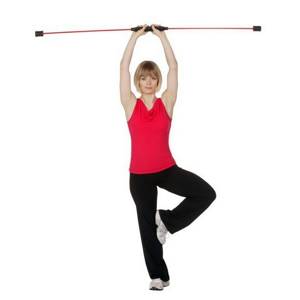
Exercises with a gymnastic stick - main options for using the apparatus (94 photo ideas)
In fitness, you often need a gymnastic stick to perform some exercises. This sports equipment strengthens many muscle groups well.
In addition to the fact that thanks to the stick it is possible to lose extra pounds, it has a positive effect on the spine and prevents many disorders in its structure.
Features of a gymnastic stick
Unlike many sports equipment, exercises with a gymnastic stick can be performed at home. The stick can be of different sizes, but for sports activities the most optimal one is 1.5 centimeters in length.
However, not everyone has the means to purchase this equipment, so it can be replaced with improvised items. For example, a mop stick or any metal pipe that has the required size and diameter.
When performing exercises, you must ensure that your back and shoulders are in the correct position. Only in this case can you achieve a positive effect from training with this equipment. You can see the correct execution in the photo of exercises with a stick.
For those who have problems with the spine, exercise with a gymnastic stick becomes mandatory.
However, before compiling a set of exercises with a stick for the back, it is necessary to coordinate and obtain the recommendations of the attending physician.
Recommendations for performing exercises with a stick
Let us immediately note that exercises with equipment must be regular, only in this case the desired effect can be achieved. Most fitness trainers recommend training in the morning, before breakfast. During the session, the body will receive a positive charge of energy, and the muscles will become toned.
If you don’t have time to study in the morning, then choose any other time. But then you need to adhere to the rules. Classes can be carried out 2 hours before meals or 1 hour after meals.
Also, classes are not conducted before bedtime; you must finish the exercises two hours before you want to go to bed.
Before starting a class, be sure to do a warm-up so that your body warms up a little. This is necessary in order to avoid injury during exercise.
Basic exercises with a stick for the spine
Body turns. During this exercise, the legs and pelvis remain motionless. The abdominal, shoulder and back muscles are involved. To perform this, you need to put the stick on your shoulders, bend your arms and slowly turn your body to the left and then to the right in this position. Performed 15 times in 3 approaches.
Body tilts. Just as in the previous exercise, the stick is placed on the shoulders, the arms are bent at the elbows. Only now it is not turns that are performed, but tilts in different directions.
Body tilts forward. The position of the gymnastic stick and body does not change, you just need to bend forward and backward.
Lunges and squats. The arms are extended forward along with the stick. It is necessary that the arms are constantly straight, and this is how squats or lunges are performed.
Exercises with a gymnastic stick in a sitting and lying position
While sitting, bend in front and in different directions. In this exercise we place the stick behind the back. Or you can lift the top and do bends.
In another exercise, also sitting, we place the stick at the feet. The legs should be straight. The main task is to reach the stick with your hands.
Exercise lying on your stomach. The arms are extended forward along with the gymnastic stick. Feet are placed shoulder-width apart. It is necessary to lift and fix the lower and upper housing. It is advisable to hold this position for about a minute.
Exercise birch tree. You need to lie on your back. Straighten your arms shoulder-width apart and take the stick by the ends. Bend your legs at the knees, and then move them through the stick. Hands are lowered along with the equipment to the floor, and legs are straightened and stretched to the top. Then slowly lower your legs, move them back through the stick and return to the starting position. Perform the exercise 10 times for 3 approaches.
There are many more exercises with this equipment. For classes, you should choose the exercises you like most, then the sport will bring joy.
This sports equipment is aimed at strengthening many muscle groups and allows you to get your body into good athletic shape. Exercises with a gymnastic stick for osteochondrosis are irreplaceable, the main thing is to coordinate them with your doctor.
Photo of exercises with a gymnastic stick
Source: //mirfitness.info/uprazhneniya-s-gimnasticheskoj-palkoj/
Lying position
When doing this set of exercises with a stick, you need to lie on your stomach with your feet shoulder-width apart. You should hold the stick in your hands extended forward. Raise your head and raise your arms. Place the stick behind your head and then place it on your shoulders. Raise the upper part of the body as high as possible, while bending as much as possible, and stay in this position for 5 seconds. Return to starting position.
In the same position, hold the stick under the buttocks behind your back. Raise your arms up, and raise your upper body and bend over, pulling your chin up. Stay in this position for five seconds. Lower your chest to the floor and return to the starting position.
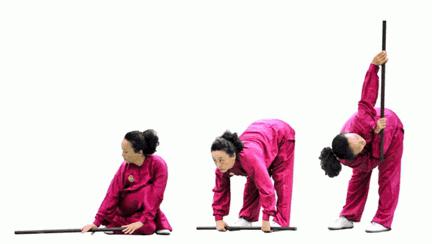
There is another set of exercises with a gymnastic stick. You need to lie on your back, keeping your legs straight together, holding the stick in front of your chest. Lift it up and bend your knees, then pull them towards your chest. Pass your legs through the stick, then straighten them up, placing the stick on the floor behind your back. Lift your pelvis up. Lower it to the floor. Bend your legs, gently pulling them towards your chest, and then lift the projectile. Walk your legs through the stick in the opposite direction. Return your arms and legs to the starting position.
Sets of exercises with a stick
Sets of exercises for 1st grade students. Exercises with objects to form correct posture. Exercises with a gymnastic stick
Category: Exercises for children
Exercises with a gymnastic stick
Complex No. 1
I.
I. p. - stand with legs apart, stick below. 1-2 - hands up, stretch, look at the stick (inhale); 3-4 - I. p. (exhale). Repeat 6-8 times at a slow pace, do not bend your arms, do not move your legs.
II.
I. p.—o. that is, the stick is below. 1 - bend forward, touch your toes with a stick (exhale); 2 - i. p. (inhale). Repeat 6-8 times at an average pace. When bending over, do not bend your legs.
III.
I. p. - stand with legs apart, stick on shoulders. 1 - turn the body to the left (exhale); 2 - i. n. (inhale); 3-4 - the same in the other direction. Repeat 4-5 times in each direction at an average pace. When turning, do not lift your heels off the floor and do not move your legs.
IV.
I. p.—o. That is, the stick is vertically in front on the floor, grab the top edge with straight hands (Fig. 4). 1 - sit down (exhale); 2 - i. p. (inhale). Repeat 6-8 times at an average pace. Squat on your toes, knees apart, keep your torso vertical, do not bend your arms.
V.
I. p.—o. e., stick below, grip shoulder-width apart. 1-2 - moving the stick slightly forward and bending your leg, step over the stick; 3-4 - step in the opposite direction. Same with the other leg. Repeat 4-5 times with each leg in turn. When stepping over a stick, do not lean forward and raise your knee higher. Breathing is voluntary, without delay.
VI.
I. p.—o. That is, the stick is below, the grip is below the shoulders. 1 - hands up, stretch, look at the stick (inhale); 2 - bending your arms, put the stick back on your shoulder blades (exhale); 3 - hands up (inhale); 4 - i. n. (exhale). Repeat 6-8 times at an average pace. When moving the stick back, try to bring your shoulder blades together and bend.
VII.
I. p.—o. e., the stick horizontally behind the back above the elbows. 1 - put your right leg back and kneel down; 2 - the same with the left leg, sitting on the heels; 3-4 - rise and put your right leg forward, stand up. The same with the left leg. Repeat 4-5 times with each leg at an average pace. Keep your torso upright, do not tilt your head. Breathing is uniform, without delays.
VIII.
I. p. - stand with legs apart, hands on the waist, stick on the floor between the legs. 1-4 - jumping along the stick on both legs, facing forward; 5-8 - the same with your back forward. Perform up to 30 jumps on your toes and switch to walking in place.
Complex No. 2
I.
I. p.—o. that is, the stick is below. 1-2 - hands up, rise on your toes, stretch and look at the stick (inhale); 3-4 - and p (exhale). Repeat 6-8 times at a slow pace.
II.
I. p. - stand with your legs apart, the stick horizontally behind your back under your elbows. 1 - turn the body to the right (exhale); 2 - i. n. (inhale); 3-4 - the same in the other direction. Repeat 4-5 times in each direction, at an average pace. When turning, do not move your legs and do not lift your heels off the floor.
III.
I. p.—o. that is, the stick is below. 1 - 4—raising your arms forward, sit on the floor in an arbitrary manner and straighten your legs without touching the floor with the stick; 5-8 - stand up without using your hands in i. p. Repeat 6-8 times at an average pace. Breathing is voluntary.
IV.
I. p. - the same. 1 - bend forward, put the stick on the floor (exhale); 2 - straighten up, arms up (inhale); 3—tilt forward; take a stick (exhale); 4 - i. p. (inhale). Repeat 6-8 times at an average pace. When bending over, do not bend your legs.
V.
I.p.-o. e., the stick horizontally behind the back under the elbows. 1 - lunge with the left leg to the side with a tilt to the right (exhale); 2 - push back to i. n. (inhale); 3-4 - the same in the other direction. Repeat 4-5 times in each direction at an average pace.
VI.
I. p. - lying on the floor on your back, stick below, grip shoulder-width apart. 1-2 - bending your left leg forward, insert it between your hand and the stick, straighten it and lower it down (stick between your legs); 3-4 - and. n. Same with the other leg. Repeat 4-6 times alternately with each leg at an average pace. Breathing is uniform, without delays.
VII.
I. p.—o. That is, the stick is in front. 1—swing your right leg forward, touching the stick with your toe (exhale); 2 - i. n. (inhale); 3-4 - the same with the left foot. Repeat 4-5 times with each leg alternately at an average pace. Do not bend your legs, do not tilt your torso forward.
VIII.
I. p. - stand with the left leg apart, hands on the waist, stick on the floor between the legs. Jump to change the position of your legs. Perform up to 30 jumps and switch to walking in place.
Exercises with a bag (cube)
Complex No. 3
I.
I. p.—o. e., a pouch on the head. Walking in place, moving forward, raising your knees high. Place your foot on the toe. Perform 60-70 steps.
II.
I. p. - legs apart, bag below. 1-2 - arms up, rise on your toes, stretch, look at the bag (inhale); 3-4 - and. n. (exhale). Repeat 6-8 times at a slow pace. When rising on your toes, do not bend your arms or lose your balance.
III.
I. p.—o. e., hands on the belt, bag on the head. 1-2 - sit down on your toes (exhale); 3-4 - and. p. (inhale). Repeat 6-8 times at a slow pace. When squatting, keep your torso vertical, knees apart.
IV.
I. p. - sitting on the back on the floor, a bag on the legs near the feet. 1-2 - slightly bending your legs, raise them above your head; 3-4 - and. n. Repeat 6-8 times at a slow pace. Do not hit your heels on the floor. Breathing is arbitrary and uniform.
V.
I. p.—sitting on the floor, arms at sides, bag on tin. 1 — swing of the right leg (exhale); 2 - i. n. (inhale); -4 - same with the other leg. Repeat 4-5 times with each leg at an average pace. Don't bend your legs. Keep your torso upright and do not lean back.
VI.
I. p. - lying on your back on the floor, hands behind your head, bag on your knees. 1-2 - bend your legs (exhale); 4 - i. p. (inhale). Repeat 6 - 8 times at a slow pace. Bending your legs, keep your shins parallel to the floor, do not lift your arms and head off the floor.
VII.
I. p.—o. e., a pouch at the bottom. 1-2 - step left in front, bend over and put the bag on the floor (exhale); —4 — placing your left foot, return to i. n. inhale); 5-6—step right, take the bag (exhale); 7—i. p. (inhale). Repeat 6-8 times at an average pace. When bending over, do not bend your legs.
VIII.
I. p. - stand with your right leg apart, hands on your belt, a bag on the floor between your legs. Jumping with changing leg position. Perform up to 30 jumps and switch to walking in place with a bag on your head.
Complex No. 4
I.
I. p.—o. e., hands on the belt, bag on the head. —2 — rising on your toes, move your elbows back, wake up (inhale); 2 - i. n. (exhale). Repeat 6-8 times at a slow pace.
II.
I. p.—o. e., arms to the sides, bag in the right hand. 1-2 - bend your right leg at the knee, arms down, touching the heel of your right foot with the bag, transfer the bag to your left hand (exhale); 3-4 - and. p. (inhale). Same with the other leg. Repeat 4-5 times with each leg at a slow pace. Do not bend your supporting leg.
III.
I. p. - stand with legs apart, hands below, bag on head. 1 - turn the body to the left (exhale); 2 -. n. (inhale); 3-4 - the same in the other direction. Repeat 4-5 times in each direction at an average pace. When turning your torso, do not bend your legs and keep them tense.
IV.
I. p.—o. e., arms to the sides, bag in the right hand. 1 - deep squat, knees together, arms down, transfer the bag to your left hand near your socks (exhale); 2 - i. n. (inhale); 3-4—the same, transferring the bag to the right hand. Repeat 4-5 times with each hand at an average pace. Squat on your entire foot.
V.
I. p. - standing on your knees, the bag in front on the floor. 1-2—unbending the right leg, take it back, bend over (inhale); 3-4 - and. n. (exhale). Same with the other leg. Do not bend your arms, do not tilt your head forward, look straight ahead.
VI.
I. p.—o. e., hands forward, bag on the head. 1-2 - squatting on the right, put the left leg as far back as possible on the toe (exhale); 3-4 - and. p. (inhale). Same with the other leg. Repeat 4-5 times with each leg at a slow pace. Keep your torso upright.
VII.
I. p. - stand with your left leg apart, a bag on your head. 1 - rise on your toes, arms to the sides; 2 - sit down on your toes; 3—turn to the right in a circle; 4—stand up, arms down (legs apart with your right). Repeat 6-8 times at a slow pace, turning first to the right, then to the left. Breathing is uniform, without delay.
VIII.
I. p.—o. e., a bag on the floor on the side. Jumping through a bag on both legs. Perform up to 25 jumps and switch to walking in place with a bag on your head.
Exercises with a jump rope
Complex No. 5
I.
I. p.—o. e., a jump rope folded in four at the bottom. 1-2 - pull the rope, arms up, stretch, look at the rope (inhale); 3-4 - and. n. (exhale). Repeat 6-8 times at a slow pace. Don't bend your arms.
II.
I. p. - wide stance, rope folded in half at the bottom. 1 - raising your arms forward to the sides and pulling the rope, turning your torso to the right (inhale); 2—i. n. exhale). The same in the other direction. Repeat 4-5 times in each direction at an average pace. When turning, do not bend your legs and do not move them from their place.
III.
I. p. - stand with legs apart, a rope folded in half on the neck, arms bent. 1-2 - springy tilts to the left, straightening the left arm down and bending the right arm and head; 3-4 - springy tilts to the right, changing the position of the hands. Repeat 4-5 times in each direction
medium pace. When performing the exercise, tighten the rope and do not bend your legs. Breathing is uniform, without delay.
IV.
I. p.—o. e., a jump rope folded in four at the bottom. —2 — raising your arms forward and pulling the rope, sit down on your toes (inhale); 3-4 - and. n. (exhale). Repeat 7-8 times at a slow pace. When squatting, keep your torso vertical, spread your knees, and look at the rope.
V.
I. p.—stand with legs apart on a jump rope, arms bent, rope taut. 1-2 - spreading your arms to the sides, bending forward (exhale); 3-4 - and. p. (inhale). Repeat 7-8 times at a slow pace. When bending over, do not bend your legs, keep your back straight, raise your head, look forward.
VI.
I. p.—o. e., a jump rope folded in four at the bottom. —4 — step over the rope with your right and left feet alternately; 5-8 - the same in the opposite direction c. n. Repeat 4-5 times at an average pace. Breathing is uniform, without delay.
V.
I. p.—left leg slightly forward in the middle of the rope; arms are bent, rope is taut. 1 - raising your arms up, bend your leg; 2 - straightening your leg down, resist with your hands. Same with the other leg. Do it 4-5 times with each leg at an average pace. Bend the south, pressing the shin to the thigh. Breathing is uniform, without delay.
VIII.
I. p.—o. e., jump rope at the back. Jump on both legs, rotating the rope forward. Rotate the rope with your hands. Perform up to 30 jumps and switch to walking in place.
Development of flexibility
The next exercise with a stick is aimed at developing flexibility. You need to stand up, holding the projectile straight in front of you. It needs to be turned in a vertical plane left and right before crossing your arms. Start to lift the stick higher and, as a result, perform the exercise in a horizontal plane above your head.
Stand up, stick down. You need to lift it up, put your hands behind your back, and lower the stick down behind you. Lift it up and return to the starting position.
Get into the same position. Raise the stick up, put your hands behind your back, and then lower it down behind you. Raise your right bent leg and reach for the projectile with your fingers. Place your foot on the floor, then lift it and reach the stick with your fingers. Place your foot on the floor, lift the projectile up, and then return to the starting position.

Stretching
You need to lie on your back, spread your legs at shoulder level, while holding the stick in front of you. Place it on the floor to your right, with your arms turned out, while trying not to tear off your shoulder blades. Return the projectile to its starting position, then place it to your left. Return to starting position.
A set of exercises with a gymnastic stick also involves the following exercises. Kneel with your right leg, move your left leg straight to the side, holding a stick on your shoulders. Turn the body to the left. Bend towards the second leg, while keeping your back straight. Straighten the body. Return to original position. Repeat the same with the other leg.
Gymnastics with a stick for children
Gymnastics with this sports equipment is useful and effective for children. It has a beneficial effect on the spine. To prevent problems with the spine, you should regularly perform morning exercises using a stick. Recommended list of exercises for children with a gymnastic stick:
- The stick is fixed in a vertical position. The child grabs the object with his hands and climbs up, then slowly falls down.
- The stick is held in the hands behind the back. Bend forward with the body, it is important to reach for the feet.
- Walking with a gymnastic stick behind your back on your shoulders. Hands can be on the object or straightened.
Children's activities
Children with poor posture should be registered with an orthopedist and receive the necessary treatment - massage, physical therapy, swimming, manual therapy, gentle treatment, orthopedic benefits and other types of conservative treatment.

With children, classes on developing posture are always carried out in a playful way. Children are asked to chop wood, ring a bell, and arch their backs. You can ask to crawl under a tight rope, walk along a line, or carry any thing on your head. Swimming is very useful for such children: in natural reservoirs in the summer, in a pool in the winter. In addition, there are special exercises for children with a stick.
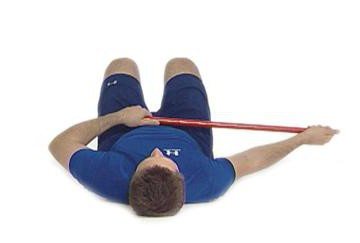
20+ ideas for developing a sense of rhythm and motor skills using claves (rhythm sticks)
30-11-2017
Many mothers often wonder how to begin to develop their children’s hearing, sense of rhythm, and ability to move to the beat of music. If all this applies to you, then a surprisingly simple and accessible instrument will come to your aid - claves or simply the rhythm of a stick. Playing this musical instrument will have a beneficial effect on the development of large and fine motor skills and will teach your children to feel the rhythm and follow it in a playful way.
We took the FLIGHT and this is what came out of it :)
Here are the games and exercises we did with our rhythm sticks.
Remember that your active participation is very important for your child! It will be much easier for your child to repeat the action if you can show him what he should do with the chopsticks, rather than just saying it.
Start with one stick:
- We roll the claves in our palms. You need to roll as if you are trying to warm your hands.
- We place the stick on the upper part of the palm (on the pads) and catch the balance so that the stick does not fall.
- By analogy, we keep balance on two fingers.
- Twist the stick in your hand, rotating your wrist.
- Twist the stick with your fingers in one hand.
- Take the clave in your fist, then grab the free edge of the stick in your other hand, as if climbing up and then down a rope. Repeat several times.
- Run the stick all over your body: behind your back, under your legs and above your head, and then make a figure eight under your feet, grabbing the stick with different hands.
|
Now you can try it with two: 20+ ideas for developing a sense of rhythm and motor skills using claves (rhythm sticks)
- Try asking your child to repeat the rhythmic pattern. For example, 1-2-3-4: hit each count; 1 (hit) – 2 (pass) – 3 (hit) – 4 (pass); 1st and 2nd 3rd and 4th etc. Then encourage your child to create his own rhythm and repeat it several times.
- Hold the sticks between your palms and roll them.
- Try to “hammer” one stick into your fist with the other, as if it were a nail and a hammer. Switch hands.
- Hold one claves in the middle in your hand, and strike the other alternately on the right and then on the left side.
- Try stacking the sticks on top of each other.
- Tap the chopsticks against each other at different volumes.
- Discuss with your child concepts such as loud/quiet, hard/soft, fast/slow.
- Tap the sticks on the ground or carpet (you can use a book) like a drum. This is the kids' favorite activity, believe me!
- Tap the claves between your legs and on the sides alternately (center, left, right). Set a simple rhythm for your child so that he can follow your movements (center, right, center, left or center, left, right, left, center, etc.).
- Cross the sticks. Try knocking on the sides, and then cross your arms and knock again. This is a VERY important skill in a child's development and helps with reading and writing.
- While standing on your feet, lower the claves low to the ground and knock, and then raise them high above your head and knock.
- Tap the chopsticks to your right and left.
- Imagine that you are conducting an orchestra.
- Invite your child to try tapping the chopsticks behind their back. This develops coordination.
- Turn on some music, march around the room and pretend that your claves are different instruments. Blow a trumpet, bang a drum, play a flute, a saxophone, play a violin, or strum a guitar. Here you are limited only by your imagination.
Not all tasks will be able to be completed by a child of a certain age, but that is the interest of claves - children of different ages will have fun playing with them, because everyone can find something interesting for themselves. If you have two children of different ages, give them each a pair of sticks and let them bang together, try something new, feel and learn.
Two small sticks, so many possibilities! You can develop fine motor skills, sequencing, spatial coordination, balance, opposites, imagination, rhythms and motor activity. And all this during the game! Not only your child, but you will also have a lot of fun.
You can order FLIGHT claves on our website and in DINATON music stores in Moscow.
|
|
|
| Claves FLIGHT FCL-11 | Claves FLIGHT FCL-12 | Claves FLIGHT FCL-13 |
|
|
|
| Claves FLIGHT FCL-22 | Claves FLIGHT FCL-23 | Claves FLIGHT FCL-33 |
Complex for children 4-6 years old
More complex exercises are designed for children of this age. For example, the following general developmental exercises with a gymnastic stick:
- Ask your baby to stretch his arms up with the stick in them, inhaling and rising on his toes. As you exhale, you need to lower your arms.
- Take the stick with your hands at a distance slightly wider than your shoulders. Raise your hands with her and lower them behind your head. This exercise must be repeated 4 times.
- While on your back with a stick in your hands, you need to imitate riding a bicycle.
- Sit cross-legged, straighten your back, hold a stick with bent arms. Turn left and right while straightening your arms.
- Walk along a low, narrow bench with your head raised straight and your arms outstretched and spread to the side. Repeat several times.
Physical education for everyone: for children and adults
Exercises with a gymnastic stick
Complex No. 1
I. I. p. - stand with legs apart, stick below. 1-2 - hands up, stretch, look at the stick (inhale); 3-4 - I. p. (exhale). Repeat 6-8 times at a slow pace, do not bend your arms, do not move your legs.
II . I. p.—o. that is, the stick is below. 1 - bend forward, touch your toes with a stick (exhale); 2 - i. p. (inhale). Repeat 6-8 times at an average pace. When bending over, do not bend your legs.
III . I. p. - stand with legs apart, stick on shoulders. 1 - turn the body to the left (exhale); 2 - i. n. (inhale); 3-4 - the same in the other direction. Repeat 4-5 times in each direction at an average pace. When turning, do not lift your heels off the floor and do not move your legs.
IV . I. p.—o. That is, the stick is vertically in front on the floor, grab the top edge with straight hands (Fig. 4). 1 - sit down (exhale); 2 - i. p. (inhale). Repeat 6-8 times at an average pace. Squat on your toes, knees apart, keep your torso vertical, do not bend your arms.
V. I. p. - o. e., stick below, grip shoulder-width apart. 1-2 - moving the stick slightly forward and bending your leg, step over the stick; 3-4 - step in the opposite direction. Same with the other leg. Repeat 4-5 times with each leg in turn. When stepping over a stick, do not lean forward and raise your knee higher. Breathing is voluntary, without delay.
VI . I. p.—o. That is, the stick is below, the grip is below the shoulders. 1 - hands up, stretch, look at the stick (inhale); 2 - bending your arms, put the stick back on your shoulder blades (exhale); 3 - hands up (inhale); 4 - i. n. (exhale). Repeat 6-8 times at an average pace. When moving the stick back, try to bring your shoulder blades together and bend.
VII . I. p.—o. e., the stick horizontally behind the back above the elbows. 1 - put your right leg back and kneel down; 2 - the same with the left leg, sitting on the heels; 3-4 - rise and put your right leg forward, stand up. The same with the left leg. Repeat 4-5 times with each leg at an average pace. Keep your torso upright, do not tilt your head. Breathing is uniform, without delays.
VIII. I. p. - stand with legs apart, hands on the waist, stick on the floor between the legs. 1-4 - jumping along the stick on both legs, facing forward; 5-8 - the same with your back forward. Perform up to 30 jumps on your toes and switch to walking in place.
Complex No. 2
I. _ I. p.—o. that is, the stick is below. 1-2 - hands up, rise on your toes, stretch and look at the stick (inhale); 3-4 - and p (exhale). Repeat 6-8 times at a slow pace.
II . I. p. - stand with your legs apart, the stick horizontally behind your back under your elbows. 1 - turn the body to the right (exhale); 2 - i. n. (inhale); 3-4 - the same in the other direction. Repeat 4-5 times in each direction, at an average pace. When turning, do not move your legs and do not lift your heels off the floor.
III . I. p.—o. that is, the stick is below. 1 - 4—raising your arms forward, sit on the floor in an arbitrary manner and straighten your legs without touching the floor with the stick; 5-8 - stand up without using your hands in i. p. Repeat 6-8 times at an average pace. Breathing is voluntary.
IV . I. p. - the same. 1 - bend forward, put the stick on the floor (exhale); 2 - straighten up, arms up (inhale); 3—tilt forward; take a stick (exhale); 4 - i. p. (inhale). Repeat 6-8 times at an average pace. When bending over, do not bend your legs.
V. _ I.p.-o. e., the stick horizontally behind the back under the elbows. 1 - lunge with the left leg to the side with a tilt to the right (exhale); 2 - push back to i. n. (inhale); 3-4 - the same in the other direction. Repeat 4-5 times in each direction at an average pace.
VI . I. p. - lying on the floor on your back, stick below, grip shoulder-width apart. 1-2 - bending your left leg forward, insert it between your hand and the stick, straighten it and lower it down (stick between your legs); 3-4 - and. n. Same with the other leg. Repeat 4-6 times alternately with each leg at an average pace. Breathing is uniform, without delays.
VII . I. p.—o. That is, the stick is in front. 1—swing your right leg forward, touching the stick with your toe (exhale); 2 - i. n. (inhale); 3-4 - the same with the left foot. Repeat 4-5 times with each leg alternately at an average pace. Do not bend your legs, do not tilt your torso forward.
VIII . I. p. - stand with the left leg apart, hands on the waist, stick on the floor between the legs. Jump to change the position of your legs. Perform up to 30 jumps and switch to walking in place.
Exercises with a bag (cube)
Complex No. 3
I. _ I. p.—o. e., a pouch on the head. Walking in place, moving forward, raising your knees high. Place your foot on the toe. Perform 60-70 steps.
II . I. p. - legs apart, bag below. 1-2 - arms up, rise on your toes, stretch, look at the bag (inhale); 3-4 - and. n. (exhale). Repeat 6-8 times at a slow pace. When rising on your toes, do not bend your arms or lose your balance.
III . I. p.—o. e., hands on the belt, bag on the head. 1-2 - sit down on your toes (exhale); 3-4 - and. p. (inhale). Repeat 6-8 times at a slow pace. When squatting, keep your torso vertical, knees apart.
IV . I. p. - sitting on the back on the floor, a bag on the legs near the feet. 1-2 - slightly bending your legs, raise them above your head; 3-4 - and. n. Repeat 6-8 times at a slow pace. Do not hit your heels on the floor. Breathing is arbitrary and uniform.
V. _ I. p.—sitting on the floor, arms at sides, bag on tin. 1 — swing of the right leg (exhale); 2 - i. n. (inhale); -4 - same with the other leg. Repeat 4-5 times with each leg at an average pace. Don't bend your legs. Keep your torso upright and do not lean back.
VI . I. p. - lying on your back on the floor, hands behind your head, bag on your knees. 1-2 - bend your legs (exhale); 4 - i. p. (inhale). Repeat 6 - 8 times at a slow pace. Bending your legs, keep your shins parallel to the floor, do not lift your arms and head off the floor.
VII . I. p.—o. e., a pouch at the bottom. 1-2 - step left in front, bend over and put the bag on the floor (exhale); —4 — placing your left foot, return to i. n. inhalation); 5-6—step right, take the bag (exhale); 7—i. p. (inhale). Repeat 6-8 times at an average pace. When bending over, do not bend your legs.
VIII . I. p. - stand with your right leg apart, hands on your belt, a bag on the floor between your legs. Jumping with changing leg position. Perform up to 30 jumps and switch to walking in place with a bag on your head.
Complex No. 4
I. _ I. p.—o. e., hands on the belt, bag on the head. —2 — rising on your toes, move your elbows back, wake up (inhale); 2 - i. n. (exhale). Repeat 6-8 times at a slow pace.
II . I. p.—o. e., arms to the sides, bag in the right hand. 1-2 - bend your right leg at the knee, arms down, touching the heel of your right foot with the bag, transfer the bag to your left hand (exhale); 3-4 - and. p. (inhale). Same with the other leg. Repeat 4-5 times with each leg at a slow pace. Do not bend your supporting leg.
III . I. p. - stand with legs apart, hands below, bag on head. 1 - turn the body to the left (exhale); 2 -. n. (inhale); 3-4 - the same in the other direction. Repeat 4-5 times in each direction at an average pace. When turning your torso, do not bend your legs and keep them tense.
IV . I. p.—o. e., arms to the sides, bag in the right hand. 1 - deep squat, knees together, arms down, transfer the bag to your left hand near your socks (exhale); 2 - i. n. (inhale); 3-4—the same, transferring the bag to the right hand. Repeat 4-5 times with each hand at an average pace. Squat on your entire foot.
V. _ I. p. - standing on your knees, the bag in front on the floor. 1-2—unbending the right leg, take it back, bend over (inhale); 3-4 - and. n. (exhale). Same with the other leg. Do not bend your arms, do not tilt your head forward, look straight ahead.
VI . I. p.—o. e., hands forward, bag on the head. 1-2 - squatting on the right, put the left leg as far back as possible on the toe (exhale); 3-4 - and. p. (inhale). Same with the other leg. Repeat 4-5 times with each leg at a slow pace. Keep your torso upright.
VII . I. p. - stand with your left leg apart, a bag on your head. 1 - rise on your toes, arms to the sides; 2 - sit down on your toes; 3—turn to the right in a circle; 4—stand up, arms down (legs apart with your right). Repeat 6-8 times at a slow pace, turning first to the right, then to the left. Breathing is uniform, without delay.
VIII . I. p.—o. e., a bag on the floor on the side. Jumping through a bag on both legs. Perform up to 25 jumps and switch to walking in place with a bag on your head.
Exercises with a jump rope
Complex No. 5
I. I. p. - o. e., a jump rope folded in four at the bottom. 1-2 - pull the rope, arms up, stretch, look at the rope (inhale); 3-4 - and. n. (exhale). Repeat 6-8 times at a slow pace. Don't bend your arms.
II . I. p. - wide stance, rope folded in half at the bottom. 1 - raising your arms forward to the sides and pulling the rope, turning your torso to the right (inhale); 2—i. n. exhale). The same in the other direction. Repeat 4-5 times in each direction at an average pace. When turning, do not bend your legs and do not move them from their place.
III . I. p. - stand with legs apart, a rope folded in half on the neck, arms bent. 1-2 - springy tilts to the left, straightening the left arm down and bending the right arm and head; 3-4 - springy tilts to the right, changing the position of the hands. Repeat 4-5 times in each direction
medium pace. When performing the exercise, tighten the rope and do not bend your legs. Breathing is uniform, without delay.
IV . I. p.—o. e., a jump rope folded in four at the bottom. —2 — raising your arms forward and pulling the rope, sit down on your toes (inhale); 3-4 - and. n. (exhale). Repeat 7-8 times at a slow pace. When squatting, keep your torso vertical, spread your knees, and look at the rope.
V. _ I. p.—stand with legs apart on a jump rope, arms bent, rope taut. 1-2 - spreading your arms to the sides, bending forward (exhale); 3-4 - and. p. (inhale). Repeat 7-8 times at a slow pace. When bending over, do not bend your legs, keep your back straight, raise your head, look forward.
VI . I. p.—o. e., a jump rope folded in four at the bottom. —4 — step over the rope with your right and left feet alternately; 5-8 - the same in the opposite direction c. n. Repeat 4-5 times at an average pace. Breathing is uniform, without delay.
V. _ I. p.—left leg slightly forward in the middle of the rope; arms are bent, rope is taut. 1 - raising your arms up, bend your leg; 2 - straightening your leg down, resist with your hands. Same with the other leg. Do it 4-5 times with each leg at an average pace. Bend the south, pressing the shin to the thigh. Breathing is uniform, without delay.
VIII. I. p.—o.
e., jump rope at the back. Jump on both legs, rotating the rope forward. Rotate the rope with your hands. Perform up to 30 jumps and switch to walking in place. “Sets of exercises for 2nd grade students. Exercises with a gymnastic stick —|||— Formation of correct posture and prevention of flat feet »

